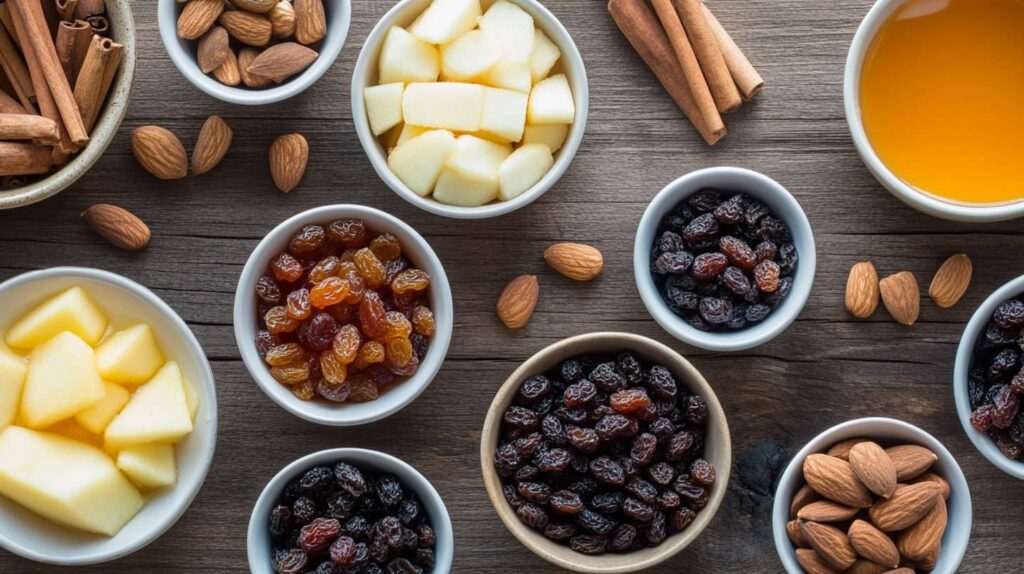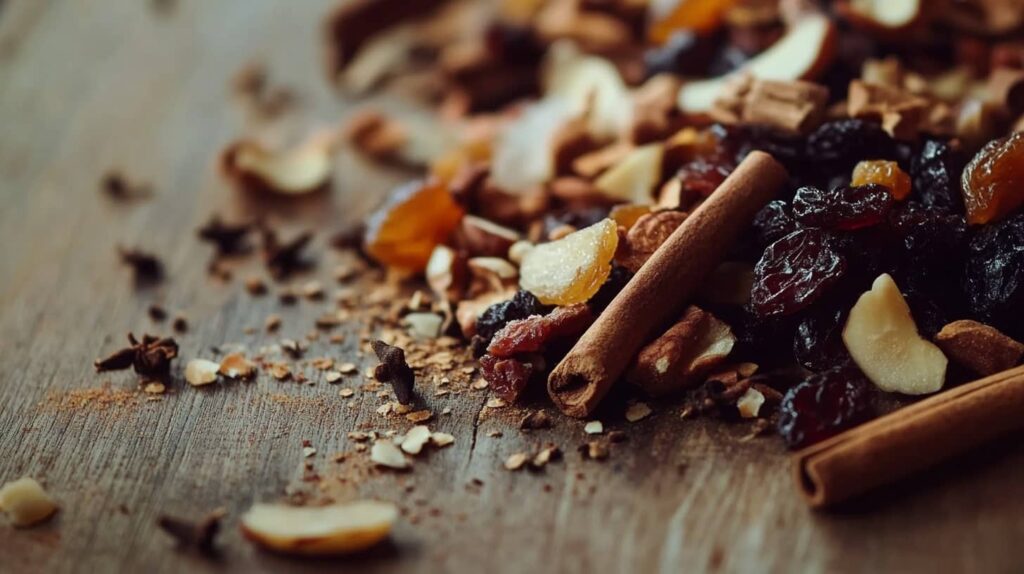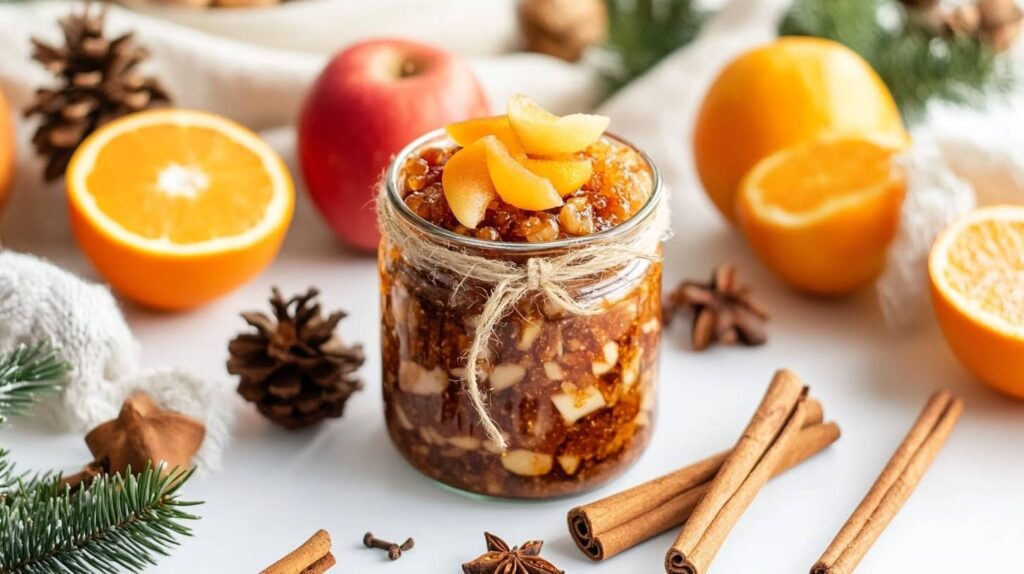
Is mincemeat healthy? This is a question many people ask, especially during the holiday season when this rich, fruity treat makes its way onto our tables. Whether you enjoy it in pies, tarts, or as a festive dessert, mincemeat has a unique flavor that sparks curiosity about its nutritional value. In this article, we’ll explore how healthy mincemeat is, its ingredients, health benefits, and ways to make it even healthier without losing its delicious taste. Let’s dive in!
Table of Contents
Introduction: Understanding Mincemeat and Its Popularity
Mincemeat often conjures images of warm holiday pies and rich, fruity flavors. But here’s the catch—it doesn’t actually contain “meat” in most modern recipes. Instead, it’s a sweet, spiced mixture of dried fruits, nuts, and sometimes a splash of alcohol.
Historically, however, mincemeat did include real meat, like beef or venison, preserved with sugar and spices. Today, it’s mostly enjoyed as a dessert filling, making it a staple during Christmas and other celebrations.
Why Is Mincemeat So Popular?
- Rich Flavor Profile: The combination of fruits, spices, and liquor creates a complex taste that people love.
- Long Shelf Life: Thanks to its preservative qualities (sugar and alcohol), mincemeat can last for months.
- Tradition: It’s a nostalgic treat that connects families and cultures through generations.
“Mincemeat isn’t just food; it’s a tradition baked into every holiday memory.”
But nostalgia aside, let’s break down the ingredients and see whether it’s actually good for you.
The History of Mincemeat: Origins and Evolution Over Time
Mincemeat dates back to the Middle Ages when preserving meat with fruits and spices was practical—and delicious! It began as a savory dish, often including beef, lamb, or game meat. Sugar and alcohol were added as natural preservatives, making it ideal for long journeys.
By the 19th century, recipes started replacing meat with more fruits and spices, transforming it into the sweet filling we know today.
Key Ingredients in Traditional Mincemeat
Modern mincemeat often includes:
- Dried Fruits (Raisins, Currants, Sultanas): Provide natural sweetness and chewy texture.
- Apples: Add moisture and a slight tartness to balance sweetness.
- Spices (Cinnamon, Nutmeg, Cloves): Create its signature warm flavor.
- Sugar: Acts as a preservative and sweetener.
- Alcohol (Brandy or Rum): Enhances flavor and preservation.
Nutritional Profile of Mincemeat: Calories, Vitamins, and Minerals

So, how healthy is mincemeat when we look at its nutrition? Let’s break it down and see whether it’s good for you or something to enjoy sparingly.
Nutritional Facts per 100g of Mincemeat
| Nutrient | Amount | % Daily Value |
|---|---|---|
| Calories | 260 kcal | 13% |
| Protein | 1.5 g | 3% |
| Carbohydrates | 55 g | 18% |
| Sugars | 45 g | 50% |
| Fat | 5 g | 8% |
| Saturated Fat | 1.2 g | 6% |
| Fiber | 3 g | 12% |
| Vitamin C | 8 mg | 9% |
| Iron | 0.7 mg | 4% |
Breaking Down the Numbers
- Calories: At 260 calories per 100g, mincemeat is calorie-dense, making portion control essential.
- Sugar Levels: With nearly 45g of sugar, it’s not ideal for diabetics or those watching their sugar intake.
- Healthy Fats: The fats mostly come from nuts, which are heart-healthy, but moderation is key.
- Fiber Boost: Thanks to dried fruits, mincemeat offers a good amount of dietary fiber.
“Mincemeat can be a treat, but treating it as a daily snack? Not so much.”
Health Benefits of Mincemeat: Why It Can Be Good for You

Despite its high sugar content, mincemeat can still be healthy when consumed in moderation. Let’s take a closer look at how healthy mincemeat really is.
1. Packed with Antioxidants
Dried fruits like raisins and sultanas are loaded with antioxidants that fight free radicals and reduce inflammation. Antioxidants help protect cells from damage, potentially lowering the risk of chronic diseases.
2. Boosts Digestive Health
Thanks to its fiber content, mincemeat aids digestion and helps prevent constipation. Fiber also keeps you feeling full longer, which may reduce overeating.
“Fiber is your gut’s best friend—and mincemeat brings plenty of it to the table.”
3. Energy-Boosting Properties
Need a quick pick-me-up? Mincemeat is high in carbohydrates, providing a fast energy boost—perfect before workouts or long days.
4. Heart-Healthy Fats
The nuts in mincemeat are rich in unsaturated fats, which can help lower bad cholesterol (LDL) and boost good cholesterol (HDL).
5. Immune Support
Fruits like apples and oranges (often included in recipes) are excellent sources of Vitamin C, which strengthens your immune system.
Common Health Concerns About Mincemeat
While it has some perks, mincemeat isn’t without its flaws. Here are a few concerns to keep in mind:
1. High Sugar Content
Too much sugar can lead to weight gain, diabetes, and tooth decay. If you’re on a low-sugar diet, traditional mincemeat might not be your best choice.
2. Calorie Overload
With 260 calories per 100g, it’s easy to overindulge—especially during the holidays when pies and pastries are everywhere.
“A little goes a long way—think of mincemeat as a treat, not a meal.”
3. Alcohol Content
Some recipes include alcohol, which may not be suitable for kids or those avoiding alcohol. Luckily, alcohol-free versions are widely available.
4. Preservatives and Additives
Store-bought options often contain preservatives and artificial flavors. Homemade mincemeat can be a healthier, additive-free alternative.
Is Mincemeat Suitable for Specific Diets?
How healthy is mincemeat for specific diets? Mincemeat is delicious, but does it fit into your dietary plan? Let’s explore how it works with popular diets like keto, vegan, and gluten-free options to find out if it’s good for you.
Keto and Low-Carb Diets: Can You Include Mincemeat?
If you’re following a keto or low-carb diet, mincemeat might seem off-limits because of its high sugar and carbohydrate content. With 55g of carbs per 100g, it can quickly push you out of ketosis.
But don’t worry! You can tweak traditional recipes to make them keto-friendly:
- Swap Sugar for Sweeteners: Use stevia, erythritol, or monk fruit instead of sugar.
- Reduce Fruits: Limit high-carb dried fruits and focus on nuts and seeds.
- Boost Healthy Fats: Add more nuts and coconut oil to increase fat content.
“Keto fans, you don’t have to say goodbye to mincemeat—just give it a low-carb makeover!”
Vegan and Vegetarian Alternatives to Traditional Mincemeat
Modern mincemeat recipes are usually vegetarian, but if you want to go fully vegan, double-check the ingredients. Some recipes include suet, a type of animal fat.
Vegan Substitutes:
- Replace suet with coconut oil or vegetable shortening.
- Opt for fruit-based binding syrups instead of honey.
- Skip alcohol or use non-alcoholic fruit juices like orange or apple cider.
Vegan Bonus Tip: Add chia seeds for extra fiber and omega-3s! 🌱
“Vegan mincemeat proves you can have your pie and eat it too—guilt-free!”
Gluten-Free Mincemeat Options for Sensitive Diets
Many store-bought mincemeat pies contain gluten from flour-based pastry crusts. However, the filling itself is typically gluten-free. If you’re sensitive to gluten, be sure to:
- Use a gluten-free crust made from almond or coconut flour.
- Make your mincemeat at home to avoid cross-contamination.
- Check labels on store-bought jars for any hidden gluten additives.
Table: Gluten-Free Ingredients Checklist
| Ingredient | Gluten-Free Option |
|---|---|
| Suet | Vegetable shortening or coconut oil |
| Sweeteners | Maple syrup or honey |
| Thickeners | Cornstarch or arrowroot powder |
| Alcohol | Gluten-free brandy or apple cider |
| Crust | Almond, oat, or rice flour-based dough |
“Going gluten-free? No worries—mincemeat can easily adapt!”
Comparing Homemade vs. Store-Bought Mincemeat: Which is Healthier?
Benefits of Making Mincemeat at Home
Homemade mincemeat gives you total control over what goes into your recipe. It’s perfect for those who want healthier, cleaner versions.
Advantages of Homemade Mincemeat:
- No Preservatives or Additives: You can skip artificial flavors and stabilizers.
- Customizable Ingredients: Add superfoods like chia seeds, flaxseeds, or dried goji berries.
- Lower Sugar Options: Use natural sweeteners like honey or dates.
- Alcohol-Free Choices: Great for kids and non-drinkers.
“Homemade mincemeat lets you create a healthy masterpiece—just the way you like it.”
Hidden Ingredients in Store-Bought Mincemeat: What to Watch For
Store-bought options can save time, but they often contain:
- High-Fructose Corn Syrup: Adds sweetness but can spike blood sugar levels.
- Preservatives like Sulfites: Used to extend shelf life but may cause allergies.
- Artificial Flavorings: Often included to mimic traditional spices.
Quick Tip: Always read the label and choose brands with simple, natural ingredients.
Tips for Making Mincemeat Healthier Without Sacrificing Taste
Love mincemeat but still wondering how healthy it is? Here’s how to enjoy it guilt-free while making it even better for you:
Using Natural Sweeteners Instead of Sugar
Refined sugar is often the main culprit behind mincemeat’s unhealthy reputation. Instead, use these:
- Maple Syrup: Adds a warm flavor and nutrients like zinc.
- Honey: Packed with antioxidants and antibacterial properties.
- Dates or Figs: Naturally sweet and rich in fiber.
“Natural sweetness doesn’t just taste better—it’s better for you too!”
Incorporating Superfoods for Extra Nutrients
Superfoods can take your mincemeat to the next level. Consider adding:
- Chia Seeds: Boosts fiber and omega-3 fatty acids.
- Flaxseeds: Rich in lignans for heart health.
- Cranberries or Blueberries: High in antioxidants and Vitamin C.
Reducing Fat Content Without Losing Flavor
Traditional recipes use suet or butter, but healthier options include:
- Coconut Oil: Adds a tropical twist while staying plant-based.
- Avocado Oil: Neutral flavor with heart-healthy fats.
- Greek Yogurt: Adds creaminess to certain recipes without excess fat.
Mincemeat Recipes for a Healthy Lifestyle

Healthy Mincemeat Pie Recipe: Low-Calorie Option
Ingredients:
- 1 cup dried fruits (raisins, apricots, cranberries)
- 1 apple, finely chopped
- 2 tbsp honey or maple syrup
- 1 tbsp chia seeds
- 1 tsp cinnamon
- ½ tsp nutmeg
- 1 tbsp lemon juice
Directions:
- Mix all ingredients in a bowl.
- Let it sit for 2 hours to absorb flavors.
- Fill your gluten-free or whole-grain crust and bake at 350°F for 25 minutes.
“A healthier pie that even Santa would approve of!”
Quick Vegan Mincemeat Recipe for Plant-Based Diets
Ingredients:
- 1 cup chopped dates
- 1 cup dried apricots
- ½ cup almonds or walnuts
- ½ cup orange juice
- 1 tsp vanilla extract
Steps:
- Blend the fruits and nuts until smooth.
- Add orange juice and vanilla extract.
- Refrigerate overnight before using.
Gluten-Free Mincemeat Options for Celiac Patients
Simply replace the crust with a gluten-free version, and check ingredients carefully for any hidden gluten.
FAQs About Mincemeat and Its Nutritional Value
Let’s tackle some of the most frequently asked questions about how healthy mincemeat is and clear up any lingering doubts.
Is Mincemeat Healthy for Weight Loss?
How healthy is mincemeat when you’re trying to lose weight? Mincemeat isn’t exactly a low-calorie food, so it may not be the best option if you’re actively trying to shed pounds.However, with some tweaks, you can make it weight-loss-friendly:
- Reduce sugar by replacing it with natural sweeteners like stevia or honey.
- Cut back on dried fruits, which are high in sugar, and add more fiber-rich nuts.
- Opt for a low-calorie crust made from almond flour or oats.
“Weight loss doesn’t mean giving up mincemeat—it just means getting creative with ingredients!”
Can Mincemeat Be Part of a Balanced Diet?
Yes, but in moderation. Mincemeat offers vitamins, minerals, and fiber, making it a decent treat. To balance it out:
- Pair it with fresh fruits for added nutrients.
- Eat smaller portions and focus on homemade versions to control sugar and fat.
- Use it as a side dish or dessert rather than the main focus of your meal.
How Often Should You Eat Mincemeat?
Mincemeat is best enjoyed occasionally, especially during festive seasons. Eating it once or twice a month can be a great way to satisfy your cravings without overloading on sugar and calories.
“Think of mincemeat as a holiday guest—it’s special, but it shouldn’t overstay its welcome.”
Does Mincemeat Contain Alcohol?
Some traditional recipes do include alcohol like brandy or rum, which acts as a preservative. However, alcohol-free versions are widely available.
Quick Fix: Replace alcohol with fruit juice like apple cider or orange juice if you prefer a non-alcoholic option.
“Alcohol or not, mincemeat can still be a flavor-packed experience.”
Are There Low-Sugar Versions of Mincemeat?
Absolutely! Many modern recipes cut down on sugar by using:
- Natural sweeteners like agave syrup or maple syrup.
- Unsweetened dried fruits for lower sugar content.
- Adding spices (cinnamon, nutmeg) to boost flavor without extra calories.
Pro Tip: Always read labels on store-bought jars to make sure they’re low in sugar.
How Long Does Homemade Mincemeat Last?
Homemade mincemeat can last 2–4 weeks in the refrigerator if stored in an airtight container. If you want to keep it longer, freeze it—it’ll stay good for up to 6 months.
Storage Tips:
- Use sterilized jars to prevent spoilage.
- Add a splash of brandy for natural preservation.
- Freeze in small batches for convenience.
“Preserve your mincemeat like a pro and enjoy it all year round!”
Explore More Delicious Recipes and Nutritional Guides
Looking to expand your recipe collection or learn more about healthy eating? Here are some exciting articles to check out:
- How to Make Healthy Mincemeat That Everyone Will Love – Discover step-by-step tips to create a healthier version of this classic treat.
- Minced Beef Nutritional Value – Surprising Health Benefits You Need – Learn about the nutritional perks of minced beef and how to include it in a balanced diet.
- Understanding Beef Tips – A Comprehensive Beef Tips Guide – Dive into this detailed guide to beef tips, their uses, and the best ways to prepare them.
- Rice Cakes: Benefits and Recipes for Healthy Snacking – Looking for quick and healthy snack ideas? Check out these tasty rice cake recipes!
These articles are packed with helpful tips, delicious recipes, and nutritional insights to keep you inspired in the kitchen! 🥗🍳
Conclusion: Final Thoughts on the Healthiness of Mincemeat
How healthy is mincemeat? The answer depends on how you prepare and consume it. While it can be good for you in moderation, tweaking the recipe can make it even better for a health-conscious diet. While traditional mincemeat can be calorie-dense and high in sugar, it also provides fiber, antioxidants, and healthy fats—making it more nutritious than most desserts.
With a few simple tweaks—like swapping sugar for natural sweeteners, adding superfoods, and choosing gluten-free or vegan options—mincemeat can easily fit into a healthy lifestyle.
Whether you’re indulging during the holidays or enjoying a quick snack, mincemeat doesn’t have to be a guilty pleasure. Instead, think of it as a treat with benefits—rich in history, flavor, and nutrients.
“Mincemeat proves that food can be both delicious and nutritious—it just takes a little creativity!”
